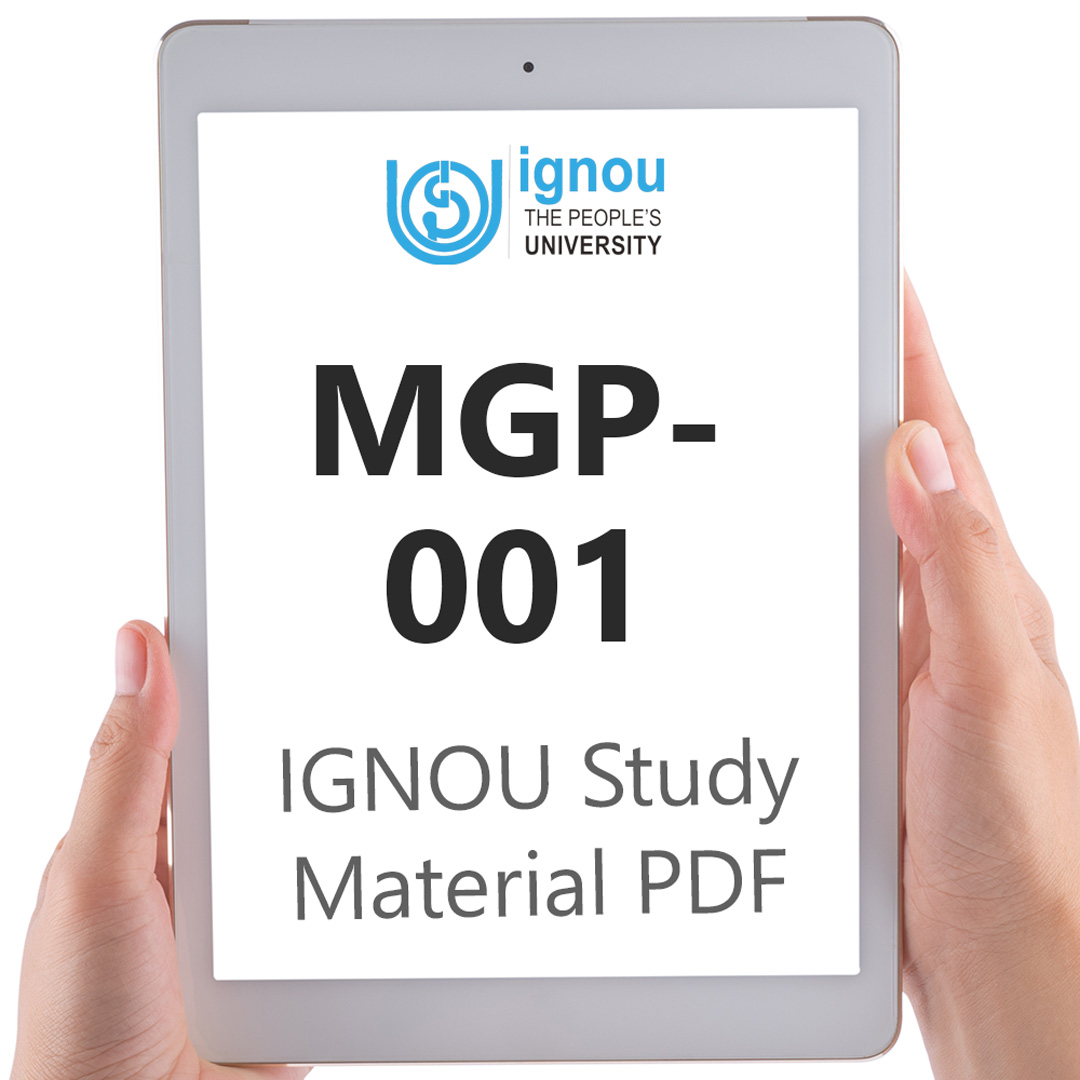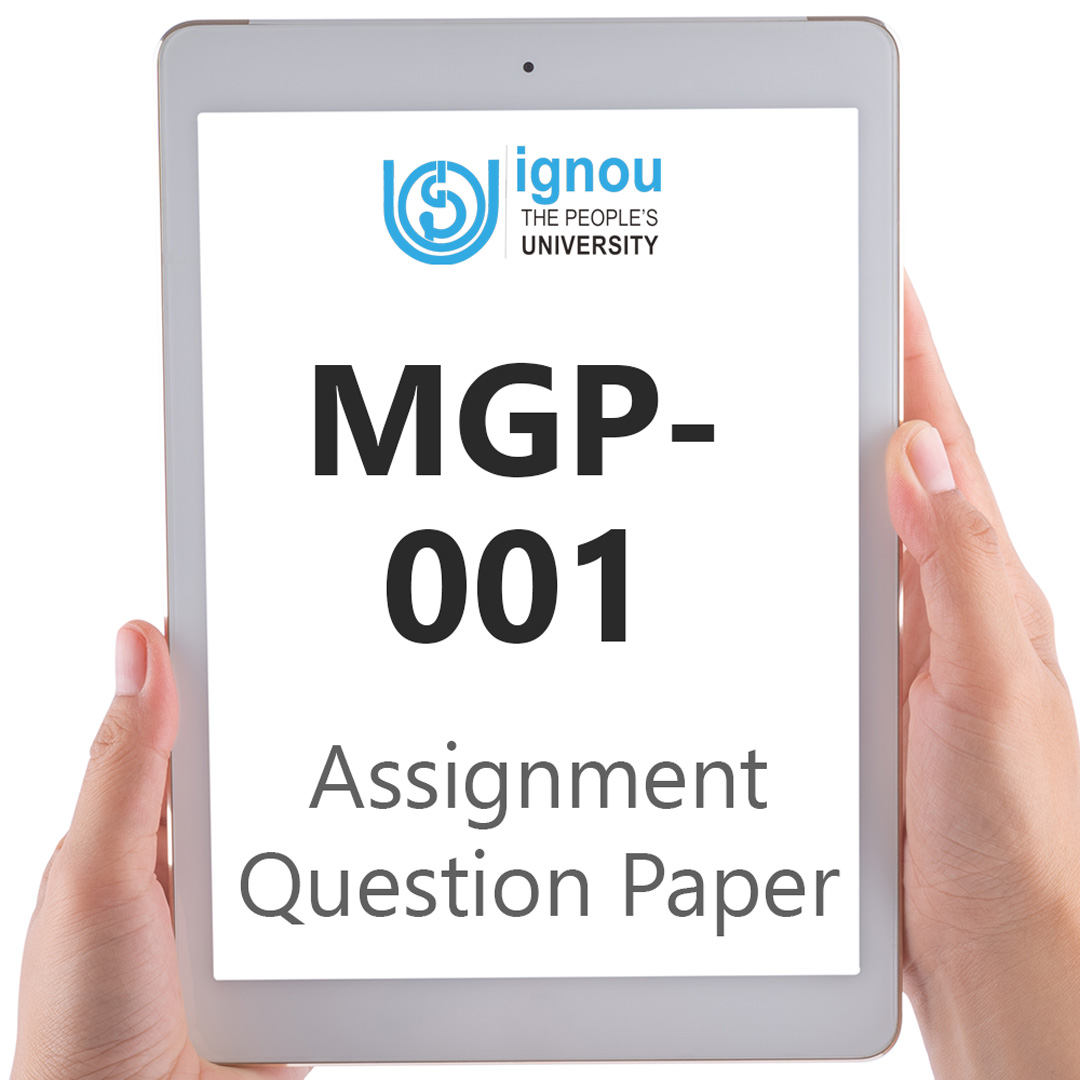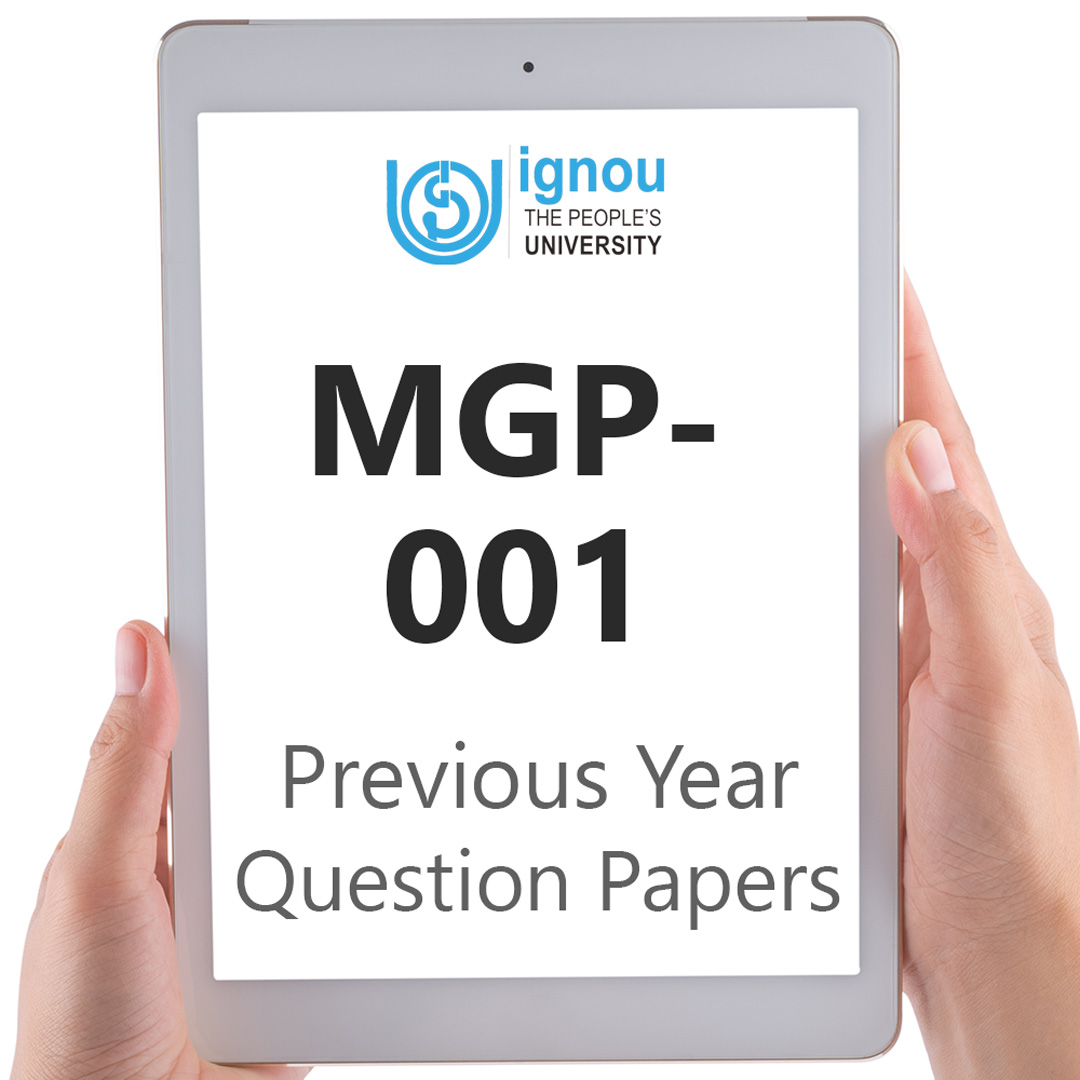If you are looking for MGP-001 IGNOU Solved Assignment solution for the subject Gandhi: The Man and His Times, you have come to the right place. MGP-001 solution on this page applies to 2022-23 session students studying in MGPS, PGDGPS, PGCGPS courses of IGNOU.
MGP-001 Solved Assignment Solution by Gyaniversity
Assignment Code: MGP-001/ASST/TMA/2022-23
Course Code: MGP-001
Assignment Name: Gandhi: The Man and his Times
Year: 2022-2023
Verification Status: Verified by Professor
Answer five questions in all, selecting at least two questions from each section. Each question is to be answered in about 500 words. Each question carries 20 marks
Section-A
Q1) What are Gandhi’s views on nationalism and internationalism? How does he reconcile the two?
Ans) Gandhi's campaign for national independence, which was founded on the imperial-colonial pattern of international relations, was in some ways an attempt to reorganise the global power structure. He want India's independence not to keep her apart from the rest of the world but rather to foster global collaboration. Only until the participating nations were sovereign and on an equal footing with international law was true international cooperation feasible.
Gandhi tackled the problem at its source; he sought to end colonialism as a system, starting with India, and so put an end to the "four-fold exploitation" in order to reclaim India's identity. Through the Satyagraha movement and a novel non-violent revolution, Gandhi aimed to accomplish this. Gandhi held that "the root of the problem does not lie in the authority of the state, but in the character of the individual which has made the existence of that state possible." This is in contrast to the Marxist-Leninist line, which undermines the role of the individual in history and maintains that an unjust social and economic system can be attacked by bringing the state under the dictatorship of the proletariat through a revolution.
Gandhi aimed to fundamentally alter the unjust social structure via individual reformation and non-violent social and political action, not by compulsion or the transfer of power to a centralised state. He referred to this as the Satyagraha movement, which is a social movement that is driven by a moral force that is created by a real desire to follow the path of Truth in one's actions both personally and in society.
Satyagraha was a state of spiritual and moral self-transformation in man, as well as a tool for achieving political, economic, and other material purposes. Through such a movement, Gandhi aimed to achieve the independent, free from colonial rule India of his dreams, where each person would have the moral fibre to contribute to a high moral order that would establish and uphold social fairness and harmony.
Gandhi intended India to develop into the perfect democracy after achieving political freedom. A democracy founded on the nonviolent principles was to be one of a kind. Gandhi envisioned a federation of village republics that were autonomous, interdependent, self-managed, decentralised, and cooperative. Such a democracy had decentralised power. There was no need for a state in Gandhi's vision of the perfect nonviolent democracy. Gandhi's concept of "anarchy" in this instance refers not to disorder but to a statelessness brought on by the existence of an enlightened harmony that does away with the need for a state to impose social norms.
In a society without violence, the distribution of power would be such that each person or cooperative group of people would be a power unit, and society would balance itself based on the existence of this power structure. There was no use of coercion of any kind in his ideal stateless democracy or enlightened anarchy, and society reached balance through individual excellence. Such a society would be made up of clusters of settled communities, with collaboration, communal work, and love governing daily life. People in a society without violence were expected to work to create a social structure that provided the greatest good for everyone.
Q2) Explain the Gandhian thought on spiritualism. How does it shape materialistic lives?
Ans) Gandhi seeks to integrate societal and personal existence, as well as the material and the spiritual. Due to this, it is easy to misunderstand and misinterpret him by putting too much emphasis on one part of his ideas and not enough on the others, distorting and perverting his meaning. Both spiritualists and materialists have regularly attacked him. He has been accused by the former of contaminating spiritual life's purity by combining it with politics and the economy.
Gandhi's emphasis on spiritual ideas was difficult to accept and is still difficult to comprehend now. They contend that the most crucial concerns are those pertaining to political freedom and economic equality and that the public shouldn't divert its attention to less crucial moral issues. They argue that no one has the authority to forego the economic and political interests of the majority for immoral motives and that this is an improper manner to manipulate the destiny of a nation or the majority. Individuals may have the freedom and in some circumstances even the responsibility to sacrifice their worldly interests for moral purposes, but a nation has no right to do so.
Gandhi does not believe that the interests of the nation and the world are at odds. Gandhi was charged with a narrow and violent nationalism by the intellectual internationalists. Both sides use quotations that have been taken out of context and are thought to be appropriate in support of their respective positions. Gandhi's ideas must be taken into account in their completeness as well as in their right context, which includes the issues he had to address and the historical realities in India.
To highlight how the components fit into his overall philosophical and theological framework, the local and temporal overemphasis, wherever it appears, must be diminished. Any underemphasized point or points must be made explicit. To make the thinking and the expression consistent with the overall plan, gaps occasionally need to be filled. It is frequently necessary to reduce the local colour in order to highlight a universal truth. The entire idea must, above all, be tied to Gandhi's own actions and way of life.
Gandhi has a propensity to deny any claim to originality, and this is closely related to his practise of utilising antiquated terminology to describe his revolutionary thoughts and actions. He stays away from jargon and technical terminology. It's probable that the charkha might have had a better chance with the upper classes than it does now if it had been as fashionable in modern times as knitting, despite the fact that it can occasionally be redundant.
After all, the charkha is more beneficial to the individual and the country than knitting, especially in light of our tropical climate and the level of unemployment and underemployment. Gandhi would have a much better chance of being understood and appreciated by the modern mind if, in his political writing, he had used the words "Disarmament" and "Open Diplomacy" rather than "Non-Violence" and "Truth," which have moral and spiritual connotations and are easily understood by the mass mind.
Q3) Describe the varied experiences of Gandhi as a law student in London.
Ans) Soon after arriving in London in 1888, Gandhi had himself taken a picture. Despite the striking features, the eyes appear to reflect confusion, fear, and longing; they appear to be moving and searching for something. The expression betrays a person who is afraid of upcoming conflicts with himself and the outside world. This timid young man was at sea in England. He often craved for his family and his mother's gentle love. Due to a false sense of social decorum and an inferiority complex that most Indians at the time suffered from, the pledge to never eat meat left him starving and embarrassed his friends.
Gandhi refused to give in to the pressure from his kind friends. "A vow was a vow and could not be broken," he believed. Near the Inner Temple, where he studied law, in Farringdon Street, close to Fleet Street, he discovered a vegetarian restaurant. He put a shilling into the A Plea for Vegetarianism by Henry Salt that was being sold at the door. He ate his first substantial dinner in England inside. This boosted his resolve even more. He was no longer a vegetarian due to the pledge, but rather out of his own free will.
His interest in vegetarianism led him to read a lot of books, and the experiments he conducted there had a significant role in his life. He took on the position of Secretary of a Vegetarian Club with youthful zeal. He was anxious to speak, but he constantly felt as though he had nothing to say or how to say it. He was unable to speak his mind openly the entire time he was in England. My innate shyness hasn't been anything but a benefit, he claims. I can, in fact.
Gandhi mostly interacted with priests, reformers, and vegetarians during his time in London. The last group was eager to shape and save his soul in their own way, but he was unmoved by their efforts. He thoroughly enjoyed studying the Gita in Arnold's translation. He also read The Light of Asia by Arnold. He studied Scripture. He was not impressed with the Old Testament. He found the teachings of the New Testament, particularly the Sermon on the Mount, appealing since they were consistent with the Vaishnavite beliefs and practises he had grown up with. He believed that despite the Gita's focus on warfare, the New Testament's core moral principles were present as well.
Gandhi was as reserved and bashful as ever throughout his three years in England, sitting tongue-tied and only ever speaking when addressed. His public speaking endeavours were a miserable failure. He struggled to speak at a farewell party for friends, managing only to remark, "Thank you, gentlemen, for having generously responded to my Invitation." He had no legal knowledge that would have helped him in his legal representation in Indian courts. However, he had stuck to the three promises he had made at his mother's urging prior to departing for England.
Only a little portion of Gandhi's memoirs, much less than his gastronomic exploits, was devoted to the reason he came to England. He matriculated at London University in June 1890 after being admitted as a student at the Inner Temple on November 6, 1888. He studied physics, Latin, French, Common, and Roman Law. He read Latin texts about Roman law. He improved his English, which made it easy for him to succeed on the final exams. He was admitted to the bar on June 10, 1891, registered with the High Court on June 11, and left for India on June 12. He had already spent two years and eight months in England and had no desire to stay another day.
Section-B
Write a short note on each part of the question in about 250 words:
Q6) (a) Communal Harmony
Ans) Mahatma Gandhi was a strong supporter of intergroup harmony. He was adamant that intolerance was the religion of the evil and that all religions encourage people to be nice and peaceful. The essence of authentic religious teaching, according to the Father of the Nation, is that one should serve and befriend everyone. Mahatma Gandhi promoted intergroup unity and urged all Indians, regardless of their religious affiliation, to band together to fight the colonial authorities. He never discovered any significant disparities between Hindus, Muslims, and other marginalised groups like Christians, Sikhs, or Parsis.
Gandhiji believed that there is an unbreakable harmony in all of creation, which is affirmed in all religions. It was this belief that inspired him to treat all faiths equally. He emphasised the importance of world peace, brotherhood, and respect for all forms of life. The realisation of this fundamental unity, according to Mahatma Gandhi, is the ultimate objective of all religions. Many people misinterpreted Gandhi's beliefs, and orthodox and even moderate Muslims were sceptical of his call for racial equality and the abolition of untouchability. Some Muslims believed that doing so would weaken their community's negotiating position and serve to increase the Hindu vote bank.
Gandhi did not adhere to the western definition of secularism and believed that politics should be spiritualized rather than separated from religion. He supported intergroup harmony and harmony between Muslims and Hindus. Maulana Abul Kalam Azad, a hard-line Pan-Islamist who later supported composite nationalism, found his views and demeanour appealing. Azad was a devoted Muslim who supported maintaining the nation's unity and communal peace. His function and attitude are sometimes compared with those of the westernised Jinnah, an unconventional Muslim who used religious justifications to fight for the rights of Muslims and a distinct state.
Q6) (b) Dr. Ambedkar’s Social and Political Ideas
Ans) Dr. Babasaheb Ambedkar was a charismatic leader of the oppressed masses in addition to being a social revolutionary and a brilliant academic. He battled tenaciously to create a society founded on the democratic values of liberty, equality, and fraternity while denouncing the caste system. He was adamant that the hierarchy of the Varna system must be destroyed before a democratic society in India can be established. Ambedkar, who was the head of the committee that wrote the Indian Constitution, was a titan among intellectuals in terms of his knowledge of the law and his proficiency in parliament.
Ambedkar, who was raised in an untouchable community, was subjected to severe caste prejudice and frequently endured humiliation as a result of his caste. Ambedkar had his education in India, and the Maharaja of Baroda, Sayajirao Gaikwad, gave him a scholarship for further study. Ambedkar attended the London School of Economics after receiving his M.A. from Columbia University. After only a brief stay in India, he returned to London, where the London School of Economics granted him an M.Sc. in Political Economy for his thesis, "Provincial Decentralization of Imperial Finance in British India." He was awarded a Doctor of Science and Law in 1922.
Before Ambedkar expressed his concerns, the Dalits had a very small part in India's social life. The caste issue had also received little attention from the social reform movement. Perhaps the first person to dislike caste system and inequity was Jyotiba Phule. Ambedkar held that social reforms should focus on eliminating the caste system since political reforms are useless without social reforms and equality.
Q2) (a) Gandhian Critique of Revolutionaries
Ans) Gandhi published "Hind Swaraj" in part to combat the violent mindset that the Indian revolutionaries had acquired. He sought to warn them that their actions amounted to a "suicidal policy," as violence only served to exacerbate existing problems in India. The only thing that could keep India's civilization safe is the "use of a different and higher weapon." He disagreed with the justifications offered by the revolutionaries for using force to drive the British out.
Gandhi believed that using force would only result in what the British had. It won't lead to "Swaraj." Gandhi, in contrast to the revolutionaries, did not think that only physically expelling the British was sufficient to secure Swaraj for India. Compared to the Swaraj of the revolutionaries, Gandhi's concept of Swaraj had considerably higher connotations. He criticised the revolutionaries' assertion that there is no relationship between the methods and the end. He valued both the methods and the end equally.
In many of his publications, Gandhi made clear where he stood on the actions of the revolutionaries. He respected their fortitude, dedication, and selflessness but did not approve of their use of force because it is counterproductive, damaging, and the incorrect strategy for achieving Swaraj. Gandhi and Bhagat Singh used different approaches to achieving independence; Bhagat Singh believed in violence and did not hesitate to use it. Gandhi firmly believed that the nation could only be set free by adhering to nonviolence to the letter. Gandhi and Bhagat Singh stood for two opposing factions in India's freedom struggle.
Q2) (b) Trace the beginning of the Civil Disobedience Movement.
Ans) Mahatma Gandhi served as the leader who started civil disobedience. Following the celebration of Independence Day in 1930, it was inaugurated. On March 12, 1930, Gandhi and 78 other Ashram members set off on foot for Dandi from the Sabarmati Ashram in Ahmedabad, marking the beginning of the civil disobedience action. Gandhi broke the salt rule after arriving in Dandi. Due to the government's monopoly over salt production, it was deemed illegal to produce salt.
The civil disobedience movement was widely embraced throughout the nation as a result of the salt satyagraha. This incident came to represent how the public disobeyed governmental regulations. The civil disobedience movement had a wide-ranging effect. It established a foundation for the freedom struggle, fostered mistrust of the British government, and popularised a new form of propaganda like the prabhat pheris, leaflets, etc. The government abolished the onerous salt tax after people in Maharashtra, Karnataka, and the Central Province disobeyed forest law and refused to pay the rural "Chaukidari tax" in Eastern India.
C. Rajagopalachari in Tamil Nadu led a comparable march from Trichinopoly to Vedaranyam, following in Gandhi's footsteps. The agitation in Darasana, Gujarat, was led at the same time by notable congresswoman Sarojini Naidu. Over 300 Satyagrahis suffered serious injuries as a result of a lathi attack by the police. There were protests, hartals, a boycott of imported goods, and later, a refusal to pay taxes as a result. This initiative drew one lakh people, including women





